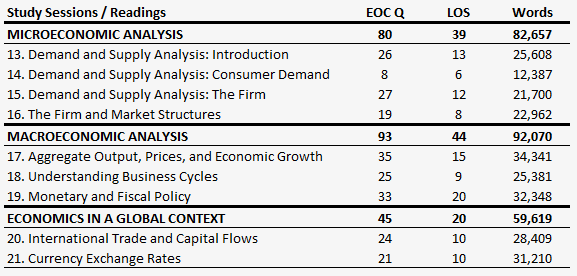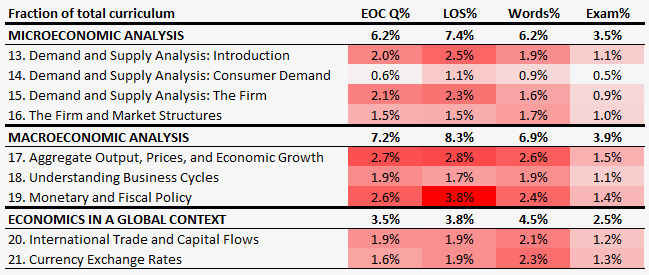What is it all about?
If you are an economist this topic should obviously be a home run, if you are not there is definitely no reason to despair, although some of the terminology may be a bit confusing if you have not seen it before.
Economics makes up an entire book (17.5% of the curriculum), despite only featuring as a guideline 10% weight on the exam. Economics is therefore the topic area where you are likely to get the least exam questions per page read (Have a look at this post if you would like a walk through of the guideline exam vs. curriculum weights for all 10 topics). Economics (along with Quants) are therefore the most obvious candidates to be studied via a condensed study guide. I would recommend having a look at Wiley CFA® Exam Review Products (previously know as Elan Guides) in case you are pressed for time (aren’t we all?). As a Financial Exam Academy reader you can use coupon code FEA and I have negotiated 10% off on your behalf (Please note that this coupon code cannot be combined with any other offers/coupons).
The readings
Economics is broken out into 3 study sessions, that are further subdivided into 9 readings. The first study session contains 4 readings on micro economic analysis. The first reading contains an introduction to demand and supply analysis (62 pages), the second reading delves into consumer demand (34 pages) whereas the next reading covers the firm perspective (56 pages), lastly the study session is completed with a walk through of different market structures (56 pages). The second study session contains 3 readings on macroeconomic analysis. The first reading contains a rather lengthy attempt to explain the supply side of the equation (86 pages), the next reading has a dig at explaining business cycles (61 pages) and the study session is rounded off with a chapter on monetary and fiscal policy (74 pages). The final study session (about economics in a global context) is divided into 2 readings. The first one deals with international trade and capital flows (68 pages) and the latter is about currency exchange rates (likewise 68 pages).
Where to focus your attention?
Certain readings feature more heavily than others in terms of the amount of LOS and end of chapter questions in relation to pages of curriculum. Particularly some of the first readings on demand and supply analysis and the last reading in the second study session about monetary and fiscal policy. Conversely the reading on the firm and market structures and the last study session on economics in a global context appear extremely light in terms of LOS and end of chapter questions relative to the amount of pages read. There is absolutely no guarantee that the number of end of chapter questions and LOS reflect the importance of the reading on exam day, but it does give some indication as to how testable the reading is, and as you know you do need to be comfortable with all of the LOS on exam day. Notice that the readings in this topic area take up a significantly larger proportion of the curriculum than their guideline exam weight would justify. So as discussed this topic is a good candidate for an abbreviated study guide if you are short of time.
If you would like an explanation about how the guideline exam weights per reading are calculated it is described under the Ethics topic area.
Please reach out at info@financialexamacademy.com if you are feeling stuck in Economics and/or if you have got a specific questions about anything else related to your studies.
Next up is Financial Reporting and Analysis (FRA)


